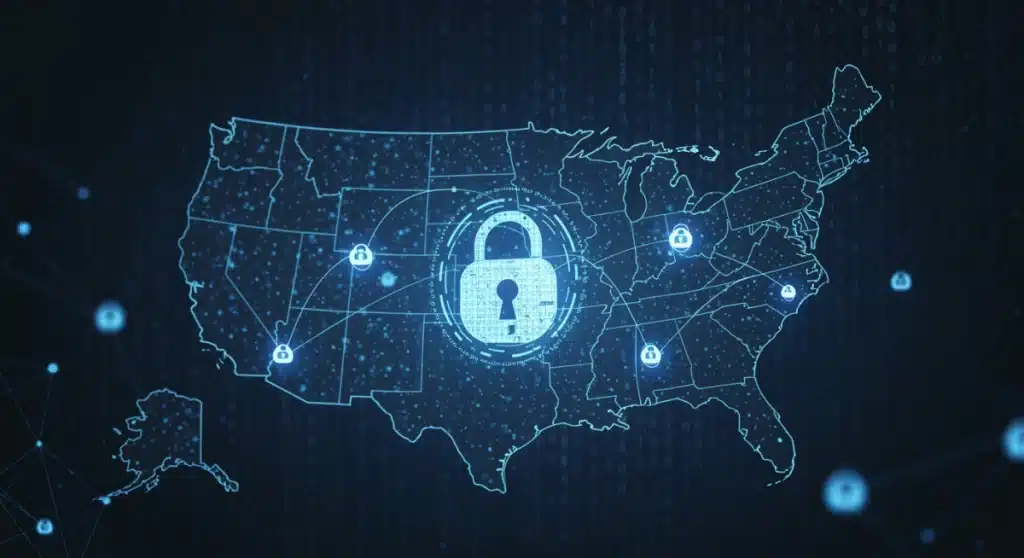US Data Breach Laws 2025: Compliance Updates You Need

Recent developments are significantly impacting US Data Breach Laws, with new regulations and amendments taking shape for 2025 compliance. Organizations across all sectors must grasp these crucial updates to navigate the evolving landscape of data protection and avoid severe penalties.
Understanding the Evolving Landscape of US Data Breach Laws
The regulatory environment surrounding data breaches in the United States is in constant flux, driven by an increasing number of cyberattacks and a heightened public demand for privacy. As of late 2024, several states and federal agencies are refining their notification requirements, preparing for a more stringent compliance era by 2025. This evolution demands that businesses not only react to incidents but proactively build robust security and response frameworks.
The fragmented nature of US data privacy laws, with each state often having its own set of rules, creates a complex web of compliance obligations. However, there’s a growing trend towards harmonization in certain aspects, particularly concerning the definition of personal information and the timelines for breach notifications. Understanding these foundational shifts is paramount for any entity handling consumer data.
Key Legislative Changes on the Horizon
Several states have either passed or are actively debating legislation that will significantly alter data breach notification protocols. These changes are not merely incremental; they often introduce new categories of protected data or shorten the window for reporting incidents. Companies operating across state lines must monitor these legislative shifts closely to ensure their incident response plans remain compliant.
- Expanded Definitions: Many new laws broaden what constitutes ‘personal information,’ now often including biometric data, precise geolocation, and even inferred demographic data.
- Reduced Notification Timelines: The standard 30-day notification period is being challenged, with some states proposing or enacting shorter windows, sometimes as brief as 72 hours, once a breach is discovered.
- Enhanced Enforcement Powers: State Attorneys General are gaining more authority to investigate and levy fines, increasing the stakes for non-compliance.
Federal Initiatives and Their Impact on Breach Notification
While state laws often grab headlines due to their immediate impact, federal initiatives also play a critical role in shaping the overall data breach landscape. Agencies like the FTC, CISA, and NIST are continually updating their guidance and, in some cases, proposing new rules that could impose federal-level notification requirements, particularly for critical infrastructure sectors. These federal efforts aim to create a baseline of security and reporting that complements state-specific mandates.
The Cybersecurity and Infrastructure Security Agency (CISA), for instance, has been actively pushing for more timely and comprehensive reporting of cyber incidents, especially for organizations deemed critical to national security or economic function. These federal pushes often serve as models or inspirations for state-level legislative action, creating a ripple effect across the country. Companies must therefore consider both federal and state requirements when crafting their incident response strategies.
CISA’s Role in Incident Reporting
CISA’s new reporting regulations, particularly under the Cyber Incident Reporting for Critical Infrastructure Act of 2022 (CIRCIA), are a game-changer for covered entities. While not a direct data breach notification law in the traditional sense, it mandates reporting of significant cyber incidents, which often include data breaches, to the federal government. This adds another layer of reporting complexity for many organizations, requiring careful coordination between legal, IT, and compliance teams.
- CIRCIA Reporting: Critical infrastructure entities must report covered cyber incidents within 72 hours and ransomware payments within 24 hours.
- Information Sharing: CISA aims to use this reported data to enhance national cybersecurity defenses and provide better threat intelligence to other organizations.
- Overlap with State Laws: Organizations must navigate potential overlaps or conflicts between CISA’s requirements and existing state data breach notification laws.
State-Specific Updates: A Patchwork of Regulations
The United States remains a complex environment for data breach compliance due to its state-by-state approach. As of 2024, nearly all 50 states have some form of data breach notification law, but the specifics vary widely. For 2025, several states are either implementing new comprehensive privacy laws that include breach notification components or are amending existing statutes to strengthen consumer protections and reporting obligations. This means businesses with a national footprint must meticulously track and comply with each jurisdiction’s unique requirements.
Understanding the nuances of each state’s law is critical. For example, California’s CCPA/CPRA continues to set a high bar for data privacy and breach notification, often influencing other states. However, emerging laws in states like Utah, Virginia, and Connecticut also introduce distinct provisions that cannot be overlooked. Organizations need to assess where their customers reside and tailor their incident response plans accordingly to ensure compliance across all relevant jurisdictions.

Notable State-Level Changes for 2025
Several states are introducing significant changes that will come into full effect by 2025. These often include stricter definitions of what constitutes a breach, expanded requirements for what information must be provided in a notification, and increased penalties for non-compliance. Companies must review their current data handling practices and breach response protocols against these new state-specific mandates.
- California (CPRA Amendments): Continued emphasis on sensitive personal information and expanded rights for consumers regarding their data, impacting breach response.
- New York (SHIELD Act Enhancements): Potential for broader scope and more prescriptive security requirements, influencing breach prevention.
- Emerging Privacy Laws: States like Texas and Florida are also developing comprehensive privacy laws that will likely include specific data breach notification clauses, adding to the complexity.
Key Definitions and Reporting Thresholds for 2025
A critical aspect of complying with US Data Breach Laws for 2025 involves understanding the precise definitions of key terms and the reporting thresholds that trigger notification obligations. The definition of ‘personal information’ continues to expand beyond traditional identifiers like names and Social Security numbers, now frequently encompassing biometric data, health information, and even IP addresses. This broadening scope means that incidents previously considered minor might now qualify as reportable breaches.
Reporting thresholds also vary significantly. Some states require notification for any unauthorized access to personal information, regardless of harm, while others mandate a ‘risk of harm’ assessment. Organizations must have clear internal guidelines and legal counsel to accurately determine when an incident crosses the threshold into a reportable data breach. Misinterpreting these definitions can lead to delayed notifications, which can result in substantial fines and reputational damage.
What Constitutes a ‘Breach’ in the New Landscape?
The definition of a data breach is moving towards a more inclusive stance. It’s no longer just about the theft of data but often includes unauthorized access, acquisition, or disclosure of personal information. The intent of the actor or the specific method of compromise is becoming less relevant than the fact that protected data has been exposed. This shift places a greater burden on organizations to secure all forms of personal data they collect and process.
- Sensitive Data Focus: Breaches involving highly sensitive data (e.g., health records, financial account numbers, biometric data) often trigger more immediate and stringent notification requirements.
- Unauthorized Access: Even if data is not exfiltrated, unauthorized access alone can constitute a breach in many jurisdictions if personal information is involved.
- Systemic Vulnerabilities: Incidents revealing systemic vulnerabilities, even without immediate data loss, may require reporting or enhanced security measures.
Best Practices for 2025 Data Breach Compliance
Given the intricate and evolving nature of US Data Breach Laws, organizations must adopt a proactive and comprehensive approach to compliance for 2025. Simply reacting to incidents is no longer sufficient; robust preventative measures, clear incident response plans, and continuous training are essential. Establishing a strong data governance framework that integrates legal, IT, and operational teams is paramount to navigating this complex regulatory environment effectively.
A key best practice involves conducting regular risk assessments and penetration testing to identify vulnerabilities before they can be exploited. Furthermore, developing and regularly testing an incident response plan ensures that, when a breach does occur, the organization can respond swiftly, efficiently, and in full compliance with all applicable laws. This includes having pre-approved communication templates and a clear chain of command for notification processes.
Developing a Robust Incident Response Plan
An effective incident response plan is the cornerstone of data breach compliance. It should be a living document, regularly updated and tested, that outlines every step an organization will take from initial detection to post-breach analysis. This plan must integrate legal counsel early in the process to ensure all actions, especially notifications, adhere to specific state and federal requirements.
- Preparation Phase: Includes risk assessments, employee training, and establishing clear roles and responsibilities within the incident response team.
- Detection & Analysis: Tools and processes for identifying security incidents, assessing their scope, and determining if personal information has been compromised.
- Containment & Eradication: Steps to stop the breach, prevent further damage, and remove the root cause of the incident.
- Notification & Recovery: Detailed procedures for notifying affected individuals, regulators, and other stakeholders, followed by system restoration and post-incident review.
Penalties and Enforcement Trends in the New Era
The financial and reputational consequences of non-compliance with US Data Breach Laws are escalating significantly towards 2025. Regulatory bodies are demonstrating a clear trend towards more aggressive enforcement actions, imposing substantial fines for violations, particularly for delayed notifications or inadequate security measures. These penalties are designed not only to punish but also to deter future non-compliance, emphasizing the importance of adherence to the new legal standards.
Beyond monetary fines, organizations face severe reputational damage, loss of customer trust, and potential legal action from affected individuals. The cost of a data breach extends far beyond regulatory penalties, often including remediation costs, legal fees, and increased cybersecurity insurance premiums. Therefore, a comprehensive understanding of potential penalties and a commitment to robust compliance are critical for organizational survival in the current climate.
Increased Scrutiny and Higher Fines
Regulators at both federal and state levels are enhancing their capabilities to investigate and prosecute data breach violations. This includes employing more forensic experts and collaborating across jurisdictions to address multi-state incidents. Fines are often calculated based on the number of affected individuals, the sensitivity of the data compromised, and the organization’s prior compliance record, making proactive compliance a financial imperative.
- State Attorney General Actions: AGs are increasingly active in pursuing enforcement actions, often leveraging consumer protection statutes in addition to specific data breach laws.
- FTC Enforcement: The Federal Trade Commission continues to enforce Section 5 of the FTC Act against companies deemed to have engaged in unfair or deceptive practices related to data security.
- Class-Action Lawsuits: Beyond regulatory fines, organizations face significant exposure to class-action lawsuits brought by affected individuals, which can result in multi-million dollar settlements.
| Key Point | Brief Description |
|---|---|
| Expanded Definitions | Personal information now includes biometrics, geolocation, and inferred data, broadening breach scope. |
| Shorter Timelines | Many states are reducing notification windows, some to as little as 72 hours post-discovery. |
| Federal Overlap | CISA’s CIRCIA adds federal reporting for critical infrastructure, creating layered compliance. |
| Increased Penalties | Regulatory bodies are imposing higher fines and more aggressive enforcement for non-compliance. |
Frequently Asked Questions About 2025 Data Breach Compliance
The most significant changes include expanded definitions of personal information, shorter notification timelines, and increased enforcement powers for state and federal regulators. Companies must prepare for broader reporting obligations and stricter adherence to new deadlines to avoid hefty penalties.
Organizations must comply with both state and federal laws, which can create a complex compliance landscape. Federal initiatives, such as CISA’s CIRCIA, often complement state-specific notification requirements. Companies need to navigate potential overlaps and ensure their response plans address all applicable jurisdictions effectively.
Preparation involves conducting regular risk assessments, updating incident response plans, and providing continuous employee training. It’s crucial to establish clear internal guidelines, ensure legal counsel is involved early in breach responses, and maintain robust data governance frameworks to align with new regulations.
Non-compliance can lead to substantial financial penalties imposed by state and federal regulators, significant reputational damage, and potential class-action lawsuits from affected individuals. The costs extend beyond fines to include remediation, legal fees, and increased cybersecurity insurance premiums, making compliance critical.
Yes, many new and updated laws specifically include biometric data within the expanded definition of ‘personal information.’ Breaches involving such highly sensitive data often trigger more immediate and stringent notification requirements, reflecting the heightened risk and potential harm associated with their compromise.
What Happens Next
As we move closer to 2025, the dynamic landscape of US Data Breach Laws will continue to evolve, demanding constant vigilance from organizations. Expect further legislative activity at both state and federal levels, with a continued emphasis on consumer protection and accountability. Companies should anticipate ongoing regulatory guidance, increased enforcement actions, and a growing expectation for proactive cybersecurity measures. Continuous monitoring of legislative developments and regular refinement of incident response capabilities will be crucial for maintaining compliance and safeguarding sensitive data in the coming year and beyond.





